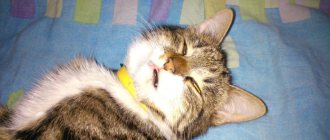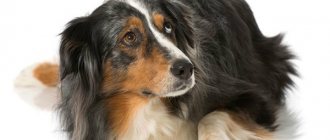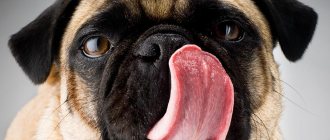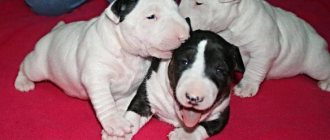Why does it occur
If your dog is coughing and burping as if he has choked on something, it is important to find out the cause.
There are several main reasons:
- A foreign object in your pet's throat or airway is the most common cause. Spasms are paroxysmal in nature, and it is possible that foam and a small amount of blood may be released. The animal refuses to eat and drink. Similar symptoms are observed in case of poisoning with toxic substances, so to find out for sure, contact a veterinarian.
- Cold infection. It is provoked, for example, by the adenovirosis virus, which is often present in places where there are large concentrations of dogs and is transmitted by airborne droplets. In the early stages of infection, the dog coughs and vomits white foam.
- Helminthic infestations. When widespread throughout the body, the dog tries to get rid of them by coughing. We are talking about parasites: Toxocara and hookworms. They enter the pulmonary system through the bloodstream and will cause inflammatory processes or tracheobronchitis.
- The collar blocks the full access of air during a walk.
- Allergic reaction. Attacks occur seasonally, when visiting places or after eating certain foods. Dogs may develop hypersensitivity to dust, household chemicals, certain types of plants, insecticidal sprays and shampoos, and insect bites. The animal sneezes and his eyes are watery.
- Tracheal collapse. A chronic disease that often develops in small breeds. It proceeds sluggishly - asymptomatically. The cough resembles a quacking sound.
- Cardiac pathologies. The owner should monitor the pet and note the appearance of associated symptoms. With heart disease, the pet's gums will be slightly bluish, wheezing and a muffled cough will appear. Fluid accumulates in the abdominal cavity, and the animal’s activity decreases significantly. Most often, heart cough occurs due to dilated caryomyopathy, but this disease is typical for large breeds. Small dogs weighing up to 7 kg rarely suffer from this disease.
- Oncological processes. Breed does not play any role in the risk of developing cancer; usually the problem lies in the animal’s advanced age. Cough in oncology is one of the main symptoms. To make an accurate diagnosis, the animal must undergo appropriate examination at a veterinary clinic. Treatment of oncological processes rarely leads to results, but trying to save a pet is the responsibility of any owner.
They continue to monitor the dog for 24 hours; if the situation does not improve, but, on the contrary, additional symptoms appear, contact a veterinarian.
Take the Attention Test! Find 10 differences! (click right here!)
Find the answer Are you bothered by some problem or question? Enter “Breed” or “Name of the problem” into the form, press Enter and you will find out everything about the issue that interests you.
Urgent seeking help from a specialist is required when:
- Excessive flow of fluid from the nose;
- Rapid weight loss;
- Vomiting;
- Lethargy, depression and a sharp decrease in activity;
- Sneezing, excessive tearing.
What to do if your dog can't clear his throat?
If your pet coughs a little and there are no other signs of pathology or changes in behavior, you should not worry. It's worth watching him for a day. If additional signs appear, such as fever, weakness, apathy and shortness of breath, it is worth taking him to the clinic.
The veterinarian will conduct an examination, diagnose the disease and prescribe treatment. Do not ignore a serious situation and go to the pharmacy for medicine without a prescription. Such behavior can be fatal for your pet, because it is impossible to diagnose the disease yourself.
In case of an attack of suffocation, you should act as follows:
- The small dog needs to be turned upside down, shaken (almost like a blanket), and patted on the back.
- When a reverse sneezing attack occurs, your pet needs to swallow saliva or take a deep breath. It is important for the owner to help the dog by pinching its nostrils or stroking its throat.
- A large animal will need to be brought to a standing position, its rear end raised slightly and the sternum firmly patted. If possible, you can carry out manipulations as with a small dog.
- It is necessary to ensure that during an attack the pet does not choke on its own tongue.
- If your pet has a short muzzle, you should place a finger in the mouth and check the opening of the airways. Representatives of the breeds often have a long and soft palate. Because of this, the airways are blocked.
- Stopping breathing requires resuscitation. Closed heart massage and ventilation are performed.
Video: what to do if your dog coughs as if he’s choking and is trying to burp something?
How to treat
Treatment for cough depends on the cause that caused it. Only a veterinarian can make a diagnosis and prescribe medications.
In case of a cold or viral disease, the animal should be given a warm corner without drafts, but with sufficient air supply.
Most often prescribed:
- Expectorants;
- Emollients;
- Antibiotics - if there is a risk of developing pneumonia.
Sometimes a dog’s cold cough goes away on its own, but it cannot be left unattended; it can become chronic.
When diagnosing cardiac pathologies, they are treated first, and expectorants and emollients are used to alleviate the condition.
Tracheal collapse is best treated early. Supplements are prescribed for the pet. If the case is advanced, an operation may be required in which the damaged tracheal rings are replaced with implants.
If the cough is caused by parasites, they are removed. The attacks stop.
Allergic cough begins to be treated after identifying the allergen and eliminating its effect on the animal. Often, the same drugs used for treating dogs as antihistamines are used for people - Suprastin, Zyrtec. But there is also a veterinary drug - Allevert. In addition to them, if your pet has allergies, they are given vitamins and products to improve immunity.
If a foreign object enters the dog’s respiratory system, it is important to contact a veterinarian as soon as possible, otherwise the animal will begin to choke. If the owner has some skills, he can examine the pharynx himself - it may be possible to remove the foreign body on his own if it is shallow. To do this, you need to press the dog's muzzle to your body, open its mouth and, using tweezers, try to pry off the object. If a foreign object is not noticed within sight, it will not be possible to do without the help of a specialist. Giving laxatives is strictly prohibited.
Oncological processes in the body are difficult to treat.
To alleviate the condition, it is recommended:
- Bronchodilators;
- Expectorants;
- Drugs that dilate the bronchi;
- Echinacea.
The dog is coughing and wheezing
Your pet may suffer from constant wheezing. Establishing the origin of which is not so easy. Wheezing can be dry, wet or whistling, depending on the cause:
- Moist wheezing occurs because air into the dog's lungs is forced to pass through a buildup of foreign fluid. With bronchitis, bronchopneumonia, pulmonary hemorrhage, blood, purulent discharge, and mucus form in the lungs, which accumulate and interfere with normal air flow;
- Dry wheezing appears due to narrowing of the lumen of the bronchi or trachea. It can also occur when a foreign object becomes lodged in the upper respiratory tract;
- Wheezing can be caused by the following conditions: vocal cord paralysis or brachycephalic syndrome.
If foam appears
The appearance of foam when a dog coughs may indicate the presence of a viral or bacterial infection. First, a dry cough appears, which often ends in vomiting white foam. Additional symptoms are fever, refusal to eat, nasal discharge, swollen tonsils, apathy. Treating viral diseases is not easy because viruses constantly mutate and do not respond to treatment.
Foam may also appear if a foreign object enters the respiratory tract. The dog tries to cough it up, and if it doesn't succeed, white or bloody foam may appear. Help should be provided immediately; damage to the respiratory tract will be dangerous due to secondary inflammation, sometimes pneumothorax.
Foam appears in heart diseases. Chest cough, which intensifies after physical activity. It develops as a result of the enlarged heart pressing on the trachea. In case of chronic heart failure, the dog begins to have pulmonary edema, but there is nothing to cough up; only foam is released.
Symptoms to watch out for
It’s worth saying right away that in order for your dog to be your friend for many years, you need to monitor and care for him. If severe coughing attacks occur, you should immediately examine the animal’s mouth and measure its body temperature. The following symptoms also indicate the development of life-threatening diseases for the dog:
• noisy breathing is heard, the dog wheezes when inhaling; • the active work of the muscles of the chest and abdomen is visible during the dog’s inhalation and exhalation; • the animal opens its mouth wide to inhale and exhale; • there is an increase in body temperature; • the mucous membranes of the mouth and tongue acquire a bluish tint; • A dog barking sounds different.
Prepare before going to the vet
In the office, you may have to provide the veterinarian with all possible assistance (hold the animal while they take blood for analysis, give an injection, extinguish aggression, calm your voice, scratch its ears, stroke it). If you know that you are terrified of blood, IVs, or definitely cannot withstand the type of medical interventions, then perhaps you should ask a friend or relative for help.
Find a veterinary certificate, veterinary passport.
Take:
- Leash;
- Collar;
- Muzzle;
- Carrying;
- A pack of napkins;
- litter;
- Bowl, water (at the veterinarian's discretion)
Prepare answers to possible questions from the veterinarian:
- Are all vaccinations up to date on the animal?
- Pet’s behavior in recent days, appetite;
- His diet;
- What drugs and medicines did you give to the animal;
- Latest test data (if available).
It’s better to make an appointment in advance - you’ll save time and be able to calculate when you’ll have to take time off. This does not apply to life-threatening situations where you will have to take an animal to a veterinary clinic without an appointment.
Be affectionate with your pet, play, talk to him. You can take his favorite toy with you so that while you wait for your turn at the reception, you can distract your friend from the new environment.
Furry, feathered or scaly ones also need to be prepared. No matter how much you want to treat your little one with something tasty, remember: you need an empty stomach. Feeding is prohibited!
You can wash your animal without using detergents. But it is important not to touch your pet if there is nasal discharge, watery eyes, salivation (salivation), dandruff, scratching, rashes, skin scabs, loss of hair/feathers/scales, wounds and other external manifestations of a potential disease.
If the veterinarian has instructed, collect the animal’s urine in a sterile container, and pick up the feces with a stick (no blades of grass, specks, or debris). Transfer the feces into a sterile container. Send to the biochemical laboratory within 6 hours. The feces are examined for eggs of roundworms, pinworms, tapeworms, liver flukes, echinoccus, alvecoccus, pork tapeworm, bovine tapeworm, and gastrointestinal bleeding is detected.
At the veterinary hospital, the animal’s blood will be analyzed for antibodies to allergens, viruses, bacteria, and parasites.
How a dog can choke: causes of suffocation
While eating, animals, unlike humans, do not talk. However, blocking the pharynx with a foreign body is still possible - often this occurs as a result of quickly eating dry food. Fish or chicken bones, pieces of wood, plastic and other materials from toys can cause danger.
There are a number of reasons leading to suffocation:
- Hasty eating
. Your pet should eat in a calm environment so that they can slowly chew and swallow food.
- Physical activity while eating
. It is typical for small, restless puppies.
- Games with foreign objects
. Small parts of toys, furniture, and clothing are dangerous for all animals. Large individuals are capable of swallowing small balls or toys whole.
- Consuming bones
. It is strictly forbidden to give chicken and fish bones to four-legged animals. Only whole beef or lamb bones are suitable as a treat - or special treats from the store.
The task of the owner of a pet friend is to closely monitor his games and feeding process. It is important to exclude dangerous foods and not allow furniture, clothing or shoes to be chewed. Small and sharp particles, even if successfully swallowed, lead to serious damage to the gastrointestinal tract.
Choosing a veterinary clinic
We determine the veterinary clinic where you plan to go. A big PR company doesn't promise quality. The price is explained by the huge amount of money invested in advertising and “signboarding” of the establishment.
It’s great if you can ask your friends about clinics where their pets were treated “humanely.” If you travel far from them, it may be worth sacrificing time for the health of your pet.
A few more tips on how to spot an unverified veterinary clinic:
- Refusal to provide certificates and licenses for veterinary activities.
- Strange and suspicious behavior of the veterinarian (inconsistency, flattery, attempts to intimidate, shouting).
- Prices are too low (compared to other organizations).
- Refusal to freely visit the veterinary clinic.
“We have a sanitary day”
Beware of scammers!
When you contact the veterinary clinic, you are informed: “we cannot accept you at this address, sanitary day/repair/inspection.” How much intelligence does a dispatcher have? The client is persuaded to have a veterinarian come to his home. The price does not change.
A veterinary clinic can exist purely nominally. And the invited “Aibolit” will not bear responsibility. There is a high probability of running into a person without a veterinary diploma or simply an unprofessional.
It is better to find time to visit the veterinary clinic on your own. This is safer for the animal.
Games on feelings
In real veterinary clinics there will be elements of “divorce”.
Veterinarians say that this is often determined by the client’s wallet. The greater the opportunity to pay for services and the more the owner worries about his pet, the more likely the animal will be prescribed additional immunostimulants, dietary supplements, water-soluble and fat-soluble vitamins, and special food. There are cases when this is really necessary (pedigreed, show animals, weakened after a serious illness). But it will be good if you ask your veterinarian in detail about the need for each appointment. Find out in detail about the results of the examination and analysis of your pet’s condition. Be persistent. Do not give in to attempts to intimidate you, be consistent in your questions. Consult a specialist who does not work at this veterinary clinic. If it turns out that half of the prescriptions are prescribed to enrich the veterinarian’s pocket, and not for the health of the animal, feel free to leave. And do not forget to leave a negative review about the organization - other owners may also suffer.
How to find out the truth
Another possible way for veterinarians to make dishonest money is to conceal the diagnosis. Let's say a veterinarian discovers a malignant tumor in a cat. But if he says that the tumor is benign and treatable. A housewife who dotes on her pet will give money for already useless procedures, medications and surgical interventions.
The veterinarian may deliberately “downplay” the diagnosis in order to earn more money. If something doesn't add up, insist on clarification. There is no need to be intimidated by unfamiliar terms - take a short break and try to find information on the Internet.
You are free to leave (or threaten to do so) to another clinic at any time.
Make sure that the veterinary clinic is honest - get tested in an independent laboratory.
Justice
What to do if an animal was injured as a result of unprofessional actions of a veterinarian:
- Write an official complaint addressed to the head of the clinic.
- File a complaint with the city veterinary department.
- You can contact Rospotrebnadzor.
- Contact a lawyer for help
The Law “On the Protection of Consumer Rights” and Article 245 of the Criminal Code “Cruelty to Animals” are the grounds for considering claims regarding the work of veterinary clinics.
First aid
The best course of action is to immediately contact a veterinarian. However, getting an appointment (even just getting to the clinic) is not always possible urgently. Therefore, it is important for every dog owner to know the basics of first aid for their pet.
If a dog chokes on a fish bone
If signs of choking are noticed, the first step is to calm down and assess the dog's condition.
Important! A bluish tongue means a serious obstruction to breathing; you should immediately consult a doctor. It is unacceptable to force feed an animal oil if the nature of the stuck object is unknown.
If a bone is stuck in the mouth, it is important to carefully open it with your hands (you can use a towel to minimize damage from the teeth) and find the damaged area. The participation of a second person who can reach the bone with his hands or tongs will help.
Rules for providing assistance when swallowing dry food
After calling a doctor, you can try to help the dog yourself. Natural gravity often comes into play - the pet is carefully lifted by the hind legs (you can grab it around the pelvis). This makes it easier for stuck food to come out.
Another method is a blow between the shoulder blades. Use the back of your hand to push the dog on the back. The main thing is to correctly calculate the force used - a careless blow to the back of a Spitz, for example, can lead to cracks in the ribs. It is important to let your dog cough and ensure that the cough does not subsequently become a severe and persistent symptom.
First aid can save a dog's life
First aid rules for swallowing sharp objects
If it is known that the dog has choked on something sharp, you need to try to determine the location of the jam. The pet's mouth is carefully opened, trying to see the object. If possible, it is carefully removed.
Rules for providing assistance when swallowing round objects
If the object is round (and this is reliably known), you can try to push it out. The pet is hugged with arms from the back, arms are crossed in the area of the lower chest and pressure is applied. Usually 5-6 presses are enough.
Saving
What to do if funds are limited and your pet needs medical care:
- Some procedures can be carried out independently. Giving a drug injection to a cat or dog is not difficult. Dressing uncomplicated wounds is also sufficient. Ask your veterinarian to teach you.
- How to properly give a pill to an animal: hide it in a lump of tightly rolled minced meat. If the animal bites through the decoy, you can crush the tablet and dissolve it in water, milk, liquid porridge, or food.
- If an animal has been prescribed a course of vitamins or some other non-medicinal but expensive drugs, it may be worth finding analogues at a lower price.
- There are various benefit programs in which you can participate. This could be, for example, sterilization, castration, or vaccination of an animal.
Important points
- Refusal to vaccinate. This is dangerous for the animal and all those who will come into contact with it (people). Vaccination is a scientifically proven method of preventing many infectious diseases. Get your animal vaccinated by a trusted veterinarian (or with his approval yourself). It is important to get vaccinated against rabies - this is a fatal disease induced by the Rabies lyssavirus virus, which cannot be cured, but can be prevented.
- Anesthesia - inhalation, intravenous, anesthesia - epidural, conduction. They are necessary so that the animal does not suffer, to prevent painful shock. The veterinarian’s “hands on” are important here - both overdose and weak anesthesia lead to serious consequences (shock, poisoning, death) for the animal.
- Sterility, antiseptic. If you see that the veterinarian does not follow the rules of antiseptics (reuses disposable syringes, diapers, bandages, does not treat hands with antiseptic after contact with the previous animal), the best choice would be to contact another veterinarian.
- Important medicines:
- Antibiotics - amoxicillin, tilozil, trimethoprim, sulfadiazine, lincomycin, marbofloxacin;
- Antipyretics - paracetamol, salicylic acid preparations, antipyrine, butadione, amidopyrine;
- Anti-inflammatory drugs - vedaprofen, choline salicylate cycloferon, aspirin;
- Anesthetics - novocaine, lidocaine, dicaine, trimecaine;
- Hemostatics - fibrinogen, thrombin, vikasol, phytomenadione, calcium chloride, etamsylate;
- Antiparasitic - praziquantel, aversectin, albendazole, ivermectin, fluralaner.
If you care what happens to your pet, you should not neglect appointments.
Don't let unverified veterinary clinics endanger your pet and profit from their owner's feelings! If you have time and desire, it is worth trying to achieve justice in case of violation of ethical or legal standards.
Physiology of swallowing
Due to the nature of the respiratory system, foreign bodies rarely enter the lungs. The larynx, in contrast, does not have protective mechanisms, and this often leads to foreign objects getting stuck.
During play, your pet may accidentally swallow a toy.
The swallowing mechanism is divided into 3 parts:
- Chewing. This phase is controlled by consciousness.
- Ingestion. An involuntary action that occurs when taste buds are irritated.
- Passage of food through the esophagus. A reflex act caused by the impact of a food coma on the walls and mucous membranes of the gastrointestinal tract.
In the second stage, the soft palate is raised and blocks the interaction between the pharynx and the nasal cavity. This process is intended to prevent food from entering the trachea, but does not affect the safety of the pharynx.
When swallowing, the palate rises and blocks access to the airway
In most cases, foreign bodies get stuck in the larynx. The entry of foreign objects into the esophagus and stomach is a fairly rare occurrence.











